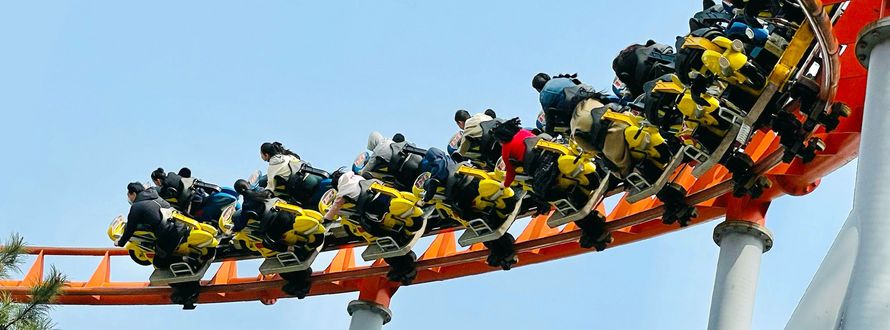Amusement parks and attractions are constantly pushing the boundaries of entertainment, seeking to deliver thrilling and immersive experiences to visitors. One crucial aspect of ensuring a safe and exciting ride is the implementation of a reliable real-time operating system (RTOS). In this use case we explore how RTOS usage can benefit amusement parks, especially in the context of roller coasters, and highlight requirements for successful implementation.
Important Requirements for RTOS Usage
1. Precise Control and Synchronization:
Roller coasters and other amusement park attractions require precise control and synchronization of various actuators, motors, and sensors to ensure smooth and synchronized movements. An RTOS, being a deterministic operating system, guarantees precise timing and coordination, ensuring that every aspect of the ride operates precisely as intended.
2. Real-Time Responsiveness & Monitoring Systems:
Safety is paramount in amusement park rides. An RTOS offers real-time responsiveness, enabling instantaneous reactions to external events or emergency situations. This ensures quick and accurate control of the ride's speed, position, and safety features, providing passengers with a safe and enjoyable experience. Real-time monitoring systems can track various parameters of rides and attractions, such as speed, temperature, and mechanical stress. These systems can detect anomalies or potential issues in real-time, allowing operators to take immediate action to prevent accidents.
3. Low Latency Interactivity:
Amusement parks increasingly incorporate interactive elements into rides, allowing passengers to engage with the experience. An RTOS reduces latency, enabling seamless interactivity between the ride's control system and passengers' input devices. This enhances the level of engagement and enjoyment, making each ride unique for visitors.
4. Fault Tolerance and Redundancy:
In critical systems like roller coasters, fault tolerance and redundancy are vital. An RTOS allows for the implementation of fault-tolerant designs and redundant control systems, ensuring continuous operation even in the event of component failures.
5. Efficient Resource Management:
Amusement park rides often operate with limited resources, including power and computing capabilities. An RTOS efficiently manages these resources, optimizing power consumption and maximizing performance to extend the ride's operational hours and reduce maintenance costs.
PikeOS: Benefits of RTOS Usage
PikeOS stands as a premier solution in ensuring safety and reliability within the dynamic environment of amusement parks. Tailored to the unique needs of the industry, PikeOS offers a cutting-edge real-time operating system (RTOS) and hypervisor technology that serves as the backbone for critical systems controlling rides and attractions. With a focus on fault tolerance, redundancy, and adherence to stringent safety standards, PikeOS empowers amusement park operators to uphold the highest levels of safety certification.
1. Safety Certification:
Amusement park rides, particularly roller coasters, require adherence to strict safety standards. PikeOS is safety-certified to various standards to ensure the highest level of safety and reliability. Developing safety-critical systems for controlling and operating rides is paramount. These systems must meet stringent safety standards depending on the region and type of ride. SYSGO's expertise in developing reliable and secure software can help amusement parks meet these standards.
2. Real-Time Determinism:
Real-time determinism is a crucial requirement for amusement park rides, as precise timing and synchronization are essential for a smooth and enjoyable experience. PikeOS offers predictable and deterministic behavior to control actuators, sensors, and other ride components in real-time.
3. Robust Error Handling:
An RTOS used in amusement parks should have robust error handling mechanisms to detect and handle potential failures effectively. Fault tolerance, graceful degradation, and recovery capabilities are critical to maintaining safe operations even under adverse conditions - no problem, thanks to PikeOS.
4. Interoperability and Integration:
The RTOS should be easily integrated with a wide range of control systems, sensors, and actuators used in amusement park rides. Interoperability ensures seamless communication and synchronization among various ride components.
5. Real-Time Debugging and Monitoring:
Debugging and monitoring capabilities are essential for diagnosing issues and ensuring continuous ride performance. PikeOS provides real-time debugging tools and monitoring interfaces to facilitate quick troubleshooting and maintenance.
Conclusion
Real-time operating systems like PikeOS play a crucial role in enhancing safety, precision, and interactivity in amusement parks and attractions, particularly roller coasters. The benefits of an RTOS, including precise control, low latency interactivity, and fault tolerance, contribute to creating thrilling and memorable experiences for visitors. Meeting important requirements, such as safety certification, real-time determinism, and robust error handling, is fundamental to ensuring the successful implementation of RTOS in amusement park rides, providing amusement park-goers with unforgettable moments of excitement and joy. From real-time monitoring systems to certification support, PikeOS equips amusement parks with the tools they need to deliver unforgettable experiences while prioritizing visitor safety above all else.

